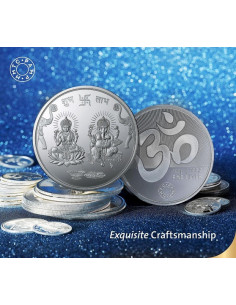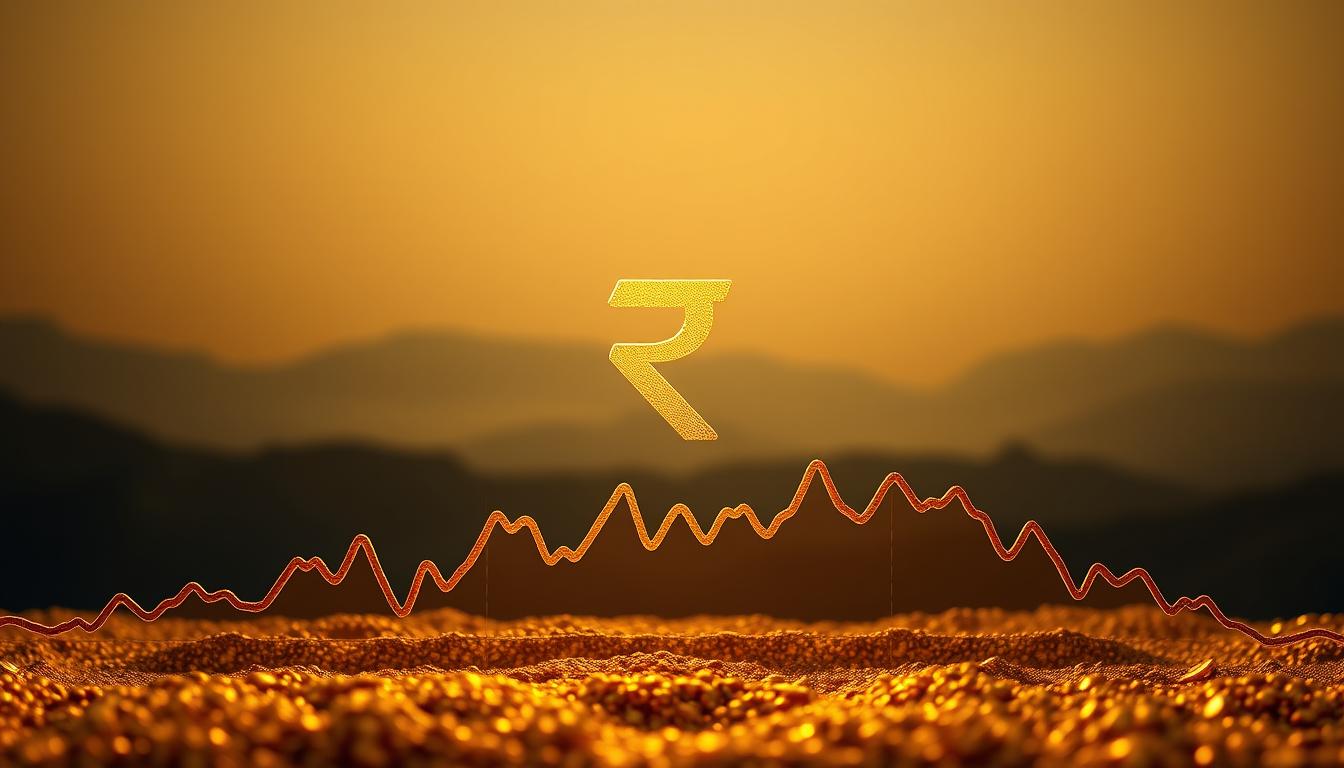Exclusive Deals & Trending Items


MMTC PAMP Silver Coin Laxmi Ganesh of 100 Gram in 999.9 Purity in Certicard / Capsule as per availabilityFineness
Shop NowGold prices are always a big deal, especially in India. Experts think gold prices might hit ₹1,00,000 per 10 grams soon. They watch trends like economic changes, global markets, and demand closely.
Analysts say inflation, currency changes, and world events could really affect gold prices. Whether you’re new to buying gold or have been investing for a while, knowing these factors is key. We’ll look at the numbers and what experts predict to help you decide.
Key Takeaways
- Experts debate if gold prices could reach ₹1,00,000 per 10g.
- Economic changes and global events influence gold prices daily.
- Investors are watching trends to plan their next moves.
- Technical analysis tools will explain how gold prices shift.
- Your decisions today could shape long-term gains in the gold market.
Let’s explore what’s behind these predictions and how to keep up with gold prices. The insights might just surprise you.
Introduction to the Gold Market
Gold has been valuable for thousands of years, from ancient treasures to today’s markets. Keeping an eye on current gold prices is key to understanding this market. Its rich history and trends influence your investments.
Market History Overview
Gold’s journey started in ancient Egypt, where it was used in temples and tombs. By the 19th century, it was a key backing for global currencies, ensuring stability. But, in 1971, the U.S. ended the gold standard, moving to today’s free-market system.
Now, exchanges update current gold prices instantly. This reflects economic changes and global demand.
- 3,000 years as a cultural and financial cornerstone
- Historic 1971 shift to floating prices
- Modern trends driven by geopolitical and economic events
Why Gold Matters to You
Gold serves as a shield against economic uncertainty. Watching current gold prices helps you react quickly in unstable markets. It’s a reliable hedge against inflation and currency value drops.
Here’s how it affects you:
- Protects savings during financial crises
- Global demand directly affects your returns
- Key part of a diversified investment strategy
Historical Trends in Gold Prices
Looking at the gold price chart shows clear patterns. Over decades, gold has grown steadily, sometimes tripling in value. For example, the Indian Bullion Jewellers’ Association (IBJA) data shows prices jumped between 2008 and 2020. These trends help predict future prices by studying past cycles.
Key moments stand out:
- In the 1970s, prices soared from $100 to over $800 per ounce.
- Between 2001 and 2011, values climbed from $250 to nearly $1,900.
- Recent years saw a 30% increase from 2020 to 2023.
These cycles show how economic changes and demand drive long-term gains.
Studying these trends helps spot opportunities. The gold price chart shows peaks and dips tied to global events. Past patterns suggest gold holds value better than many assets. Understanding these cycles can guide your investment decisions today.
Understanding Gold Prices
Gold’s value isn’t a mystery. It’s shaped by global forces you can learn to track. Knowing what influences prices helps you protect your savings smartly.
What Drives Gold Valuations?
Three key forces move prices daily:
- Inflation: When costs rise, gold often becomes more valuable as a store of wealth.
- Political events: Conflicts or crises boost demand for gold as a safe asset.
- Currency trends: A weaker rupee can push local gold prices higher.
Impact on Your Investments
These shifts directly affect your returns. Here’s how to stay ahead:
- Track live gold prices daily using platforms like the Bombay Bullion Association or the LBMA.
- Watch economic reports—rising inflation or dollar weakness often mean higher prices.
- Compare live gold prices with historical data to spot buying/selling windows.
Changes in global markets ripple into your portfolio. Staying informed helps you avoid losses and seize opportunities.
Expert Insights and Predictions
Leading analysts and traders keep a close eye on gold price today to predict trends. Experts like Mahendra Luniya point out how global events and economic changes affect prices. Their advice helps investors make smart choices.
“Gold remains a safe haven during uncertainties. Tracking gold price today is key to spotting opportunities.”
Perspectives from Industry Leaders
Experts look at many factors:
- Inflation rates and currency changes
- Central bank policies
- Geopolitical tensions
These elements shape their views ongold price todayand its future.
Forecasting Future Movements
Forecasting involves:
- Technical analysis of past charts
- Economic indicators
- Market sentiment surveys
By using these tools, analysts aim to accurately forecastgold price todaytrends.
Key Drivers of Price Increase
Knowing what affects gold market prices is key to smart investing. Three main factors influence these changes:
| Factor | Impact on Gold Market Prices | Example |
|---|---|---|
| Geopolitical Tensions | Rising instability boosts demand | Conflicts in major economies |
| Inflation Trends | Higher costs drive safe-haven buying | India’s 2023 inflation hitting 7% |
| Economic Slowdowns | Uncertainty pushes investors toward gold | Global recession fears in 2024 |
When inflation goes up, people often buy gold to save their money. Political conflicts, like those in the Middle East, make things uncertain. This uncertainty increases demand for gold.
Economic slowdowns also play a role. They make paper currencies weaker, making gold more valuable. These factors together push gold market prices up.
Keep an eye on these drivers to find good times to buy or sell. This way, you can keep your portfolio safe during tough times.
Current Gold Price Analysis
Staying ahead in gold prices means making smart choices based on data. Let’s look at today’s trends and what they say for gold price prediction.
Live Gold Prices Snapshot
Keep an eye on real-time updates to catch trends:
- Current price (per 10g): ₹XX,XXX (as of today)
- 24-hour change: +X.XX%
- Influences: US dollar changes, inflation rates
Gold Price Today vs. Historical Data
Compare today’s numbers with past highs to spot patterns:
| Year | Price | % Change vs. Previous Year |
|---|---|---|
| 2023 | ₹65,000 | +7.2% |
| 2022 | ₹60,600 | +6.8% |
| 2021 | ₹56,700 | +12.3% |
Experts at World Gold Council say 2023 trends match gold price prediction models. They predict steady growth. Keep an eye on these changes to adjust your investments wisely.
Decoding the Gold Price Chart
Gold price charts hold secrets in historical gold prices. Start by looking at trends and patterns. These shape the future. Let’s learn how to read these charts for better decisions.
How to Read Price Movements
- Identify trends: Look for upward or downward slopes in price lines. A rising trend shows demand; a falling one may signal caution.
- Spot support/resistance levels: These are price points where buying or selling pressure changes. Past historical gold prices often mark these key levels.
- Check volume: High trading volumes during price changes confirm trend strength. Low volume might mean uncertainty.
Interpreting Trends and Patterns
Patterns like “head and shoulders” or “cup and handle” reveal shifts in investor sentiment. For example, a long-term upward trend in historical gold prices might suggest a bullish outlook.
Remember: Trends rarely change overnight. Use charts to spot gradual shifts, not daily noise. Analysts often compare current prices to past cycles to predict future behavior.
Global Market Influences on Gold
Looking at gold price analysis means more than just local trends. Big global events like wars, trade disputes, or central bank actions affect gold’s value. For instance, when interest rates go up, gold seems less appealing than bonds. But in times of crisis, it’s seen as a safe place to put money.
- Inflation spikes: Rising prices worldwide push investors toward gold as a hedge.
- Geopolitical conflicts: Tensions in regions like the Middle East boost demand for gold.
- Currency fluctuations: A weaker dollar lifts gold’s value in other currencies.
| Factor | Impact on Gold |
|---|---|
| Global Recession | Increases demand as a safe asset |
| US-China Trade Wars | Raise uncertainty, driving gold prices higher |
| Oil Price Volatility | Linked to inflation fears, boosting gold |
War in Ukraine or a Federal Reserve rate hike halfway across the world can shift prices overnight. Keep an eye on these factors in real time to make smart choices. Be ready to see how global changes can open up new chances in your portfolio.
Technical Factors Affecting Prices
Traders use technical tools to predict gold prices. Charts and indicators help spot patterns. These patterns guide buying or selling decisions. Here’s how to use these tools effectively.
Chart Indicators and Tools
- Moving averages: Track 50-day and 200-day trends to identify long-term directions.
- RSI (Relative Strength Index): Measures momentum on a 14-period scale. Values above 70 may signal overbought gold prices; below 30 suggests oversold conditions.
- Bollinger Bands: Shows price volatility. Wide bands indicate high uncertainty, while narrow bands point to potential breakout points.
Key Technical Signals
Watch for these signs to time your moves:
- Resistance Breakouts: A price breaking above a resistance level could signal a new upward trend for gold prices.
- Trendlines: Draw lines connecting peaks or valleys to spot support or resistance zones.
- Divergence: When gold prices rise but momentum indicators fall, it may warn of an impending reversal.
Combining these tools helps decode market signals. For instance, a 50-day moving average crossing above the 200-day line (a “golden cross”) often hints at a bullish shift. Always pair technical analysis with broader economic data for informed decisions.
Impact of Economic Policies
Economic policies have a big role in current gold prices. They can change how much people want to buy gold. In India, things like taxes or import duties can make a big difference. Let’s look at how these policies affect your investments:
- Inflation Control: When inflation goes up, people turn to gold. This makes prices go up too.
- Interest Rates: If bank rates are low, gold looks more appealing than savings accounts.
- Import Duties: Higher tariffs mean more money spent on imports. This makes gold prices go up.
| Policy Type | Example | Impact |
|---|---|---|
| Fiscal Policy | 2023 Gold Import Duty Hike | Raised local prices by 5–8% |
| Monetary Policy | RBI Rate Cuts (2022–23) | Gold demand rose by 12% |
For instance, India’s 2023 import duty hike to 15% made current gold prices jump by ₹2,000 per 10g. When the RBI cuts rates, more people buy gold. Keep an eye on these policies to buy gold at the right time. Economic changes don’t just affect prices; they also shape your wealth strategy.
Investment Strategies in the Gold Market
Creating a smart gold portfolio begins with knowing how to use tools like the gold price chart. This tool helps you see trends and choose the right time to invest. Let’s look at ways to balance risk and growth.
Diversification Tips for You
Spread your investments to lower risk:
- Buy physical gold (coins, bars) for tangible assets
- Invest in gold ETFs like ETF Securities Gold ETC for liquidity
- Combine with other assets like bonds or stocks
Long-Term vs. Short-Term Investments
“Long-term holdings thrive on patience,” says analyst Ritu Gupta. “Short-term gains need active monitoring.”
Gold price chart analysis is crucial here. For long-term strategies:
- Buy steadily over time (dollar-cost averaging)
- Aim for 5+ years to ride inflation trends
Short-term traders should:
- Track daily gold price chart patterns
- Set clear profit and stop-loss targets
Remember: Your goals decide your approach. Mix strategies based on your risk appetite and time availability.
Risks and Opportunities in Gold Investing
Investing in gold can be rewarding but also comes with risks. Live gold prices can change fast, offering both challenges and opportunities to grow your wealth. Staying informed is key to managing these changes well.
Weighing the Pros and Cons
- Pros: Gold can protect against inflation and economic uncertainty. Its value remains strong due to global demand.
- Cons: Sudden drops in live gold prices can hurt short-term gains. Costs for storage and liquidity issues can also impact returns.
Risk Management Strategies
Here are ways to protect your investments:
- Keep an eye on live gold prices every day with trusted platforms to catch trends.
- Diversify by investing in physical gold, ETFs, and jewelry to lessen reliance on one asset.
- Set clear profit goals and exit points to avoid making emotional decisions during price changes.
Watching live gold prices and being adaptable helps you adjust to market changes. A balanced approach of caution and proactive steps can create a strong investment strategy.
Comparing Historical and Current Values
Looking at past and presentgold price todaytrends can help you make smarter choices. Experts use historical data from the Indian Bullion Jewellers’ Association (IBJA) and market shifts to guide decisions.
Lessons from the Past
- Past spikes often followed crises, like the 2020 pandemic-driven rise.
- Inflation and global events like wars or elections have shaped trends.
What This Means for Your Future
Today’s gold price today mirrors current economic factors. Use these steps:
- Track gold price today via trusted platforms daily.
- Compare with historical lows and highs to spot patterns.
History shows patience pays off in gold, says IBJA analyst Rameshwar Mehta.
Understanding how past cycles influence today’s gold price today helps you plan. Stay informed to capitalize on trends without guessing.
Future Outlook for Gold Investment
Experts think gold prices might go up as the world faces more uncertainty. Inflation and global tensions make people want safe assets like gold. CNBC and the World Gold Council see good times ahead for gold.
- Inflation rates and central bank policies directly impact gold market prices.
- Political instability and currency fluctuations may drive increased gold purchases.
- Technological advancements in gold-backed digital assets could reshape investment opportunities.
Here’s what leading institutions foresee:
| Year | Projected Price (USD/oz) | Source |
|---|---|---|
| 2025 | $2,500 | CNBC |
| 2027 | $2,800 | World Gold Council |
| 2030 | $3,200 | Bloomberg |
These predictions show promising chances. Keep up with gold prices on sites like the Reserve Bank of India or Bloomberg. Diversify your investments based on these trends to meet your financial targets.
Conclusion
As we finish looking at gold’s future value, remember that reaching ₹1,00,000 per 10g depends on many things. Experts say inflation, world events, and interest rates play big roles. Your choices should match these factors and your financial goals.
Gold’s history shows it does well when markets are unstable. While predictions vary, knowing what drives prices is important. It’s all about finding the right balance between risks and chances.
Keep up with gold price predictions by watching the economy and global markets. Prices might go up or down, but your plan should be adaptable. Use what you’ve learned to make smart investment choices. Always talk to experts before making big decisions.
Gold is still seen as a safe investment. Watching for new trends helps you stay ahead. When reviewing your investments, focus on facts over guesses. The future of gold prices depends on both local and global factors.




















2 Responses
Interesting take onGold Price Comment Analysis the potential for gold to reach ₹1,00,000 per 10g. With ongoing global uncertainty and inflationary pressures, it makes sense that investors are turning to gold as a hedge. I’d be curious to see how central bank policies and geopolitical tensions further impact these projections in the coming months.
With inflation on the rise and central banks continuing to buy gold, it seems like we’re heading toward higher price territory. I’d be curious to know how seasonal demand in India might further influence this trend.